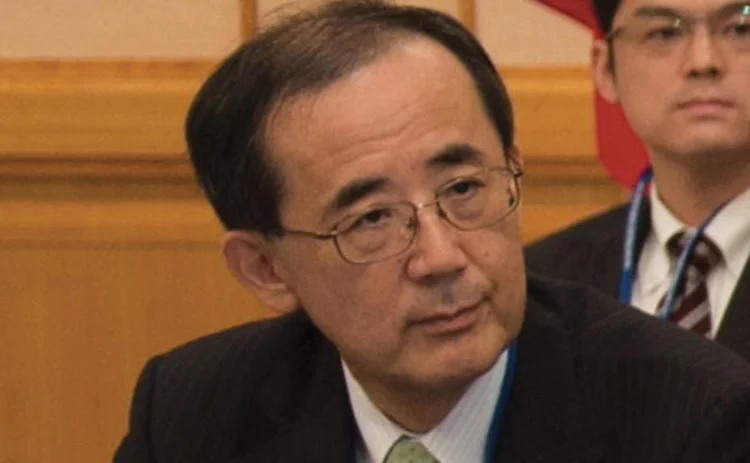
Lifetime achievement: Masaaki Shirakawa
The veteran BoJ central banker called out the limits of monetary policy

Masaaki Shirakawa served nearly four decades at the Bank of Japan. He joined the institution as a graduate trainee in 1972, and remained at the central bank, holding increasingly senior positions, until 2006. In 2008, amid the global financial crisis, he was appointed acting BoJ governor, and then governor, remaining in office until 2013.
Shirakawa worked across a range of functions at the Bank of Japan, including monetary policy, financial markets, payment systems and financial supervision. These experiences provided him with a broad perspective on the role of a central bank, which he says “profoundly affected” his governorship. His career covered the emergence and bursting of Japan’s twin stock and property market bubble. He witnessed firsthand the myriad of challenges involved in propping up and restructuring the Japanese financial sector after the bubble burst.
As governor, Shirakawa was instrumental in co-ordinating major central bank responses with the heads of the Federal Reserve System and other central banks that helped to prevent a systemic meltdown during the global financial crisis. He also took a key leadership role after his country was hit by the Great East Japan Earthquake in 2011. As he said in his writings, his five years as governor were “filled with turbulence” and he felt that each day he was “running as fast as I could into a strong wind”. Throughout his time in office and afterwards, Shirakawa has offered a well-considered and cautionary voice against much of the prevailing economic and central banking policy wisdom. Despite being a distinguished economist, he has remained wary of adhering religiously to the popular economic doctrine of the day and has remained cognisant of the flaws in economic assumptions.
Shirakawa has been steadfast in stressing the importance of considering the interconnected financial sector and real-world factors, such as fiscal position and demographic change, when adopting policy. And he has consistently shared his experiences of the development of asset bubbles, which – as was the case with Japan – do not necessarily show up in typical inflation statistics. He highlighted problems associated with an overreliance on asset purchases by central banks – something he also had early experience in – and issued warnings about the risks associated with a specific inflation target.
Ultimately, in an understated but courageous manner, particularly though the publication of his book, Tumultuous times: central banking in an era of crisis, Shirakawa has called out the limits of monetary policy and forcefully defended the Bank of Japan’s de facto independence despite external criticism from Western economists, much of which he views as ill-informed.
Joining the bank
Shirakawa’s interest in economics began while he was a student in the late 1960s at the University of Tokyo. When his legal studies course was disrupted by student unrest, he joined a study group reading Paul Samuelson’s Economics. It prompted him to consider a change in degree subject, which he undertook after starting to read – but failing to complete at the time – John Hicks’ Value and capital.
After securing a bachelor’s degree in economics, Shirakawa joined some 30 others as part of the Bank of Japan’s graduate intake in 1972. The move fitted with his aspirations to use his economics skills in the pursuit of public service. He was first appointed to the international department and was soon given the task of handling the paperwork for the management of Japan’s foreign exchange reserves, which stood at just $16.7 billion by March 1972.
It was around this time that developed economies had started to manage fiat money as major currencies were ‘floated’ in the aftermath of the ‘Nixon shock’ in 1971, when the US stopped allowing foreign central banks to exchange dollars for gold, and the Smithsonian agreement that temporarily increased the yen’s parity to the US dollar from ¥360 to ¥308. This led to efforts to manage monetary policy via money supply and inflation targeting. Shirakawa’s time at the international department nurtured a lifelong interest in the international financial system and economic thinking beyond Japan.
Chicago-bound
Three years after joining the BoJ, Shirakawa entered a graduate programme for two years at the University of Chicago’s Graduate School of Business, where he learnt about price theory and money. His faculty professors included Milton Friedman, Theodore Schultz, George Stigler, Ronald Coase, Gary Becker, Robert Lucas and James Heckman. But the former policy-maker says he was most influenced by Becker and his analysis of human capital, whose worked included factors such as reproduction and crime and identifying issues that “could be pursued rigorously and analytically”. Shirakawa would reflect on Becker’s work later in his career as Japan experienced sharp demographic shifts, including a fall in its working age population.
Shirakawa has said he learned three main lessons from his time in Chicago: to look for the logical explanations of behaviour based on people’s incentives; the importance of empiricism; and the usefulness of explaining things intuitively. He also recognised that theoretical models represent simplifications of the real world’s complexities, indicating he may not have been fully convinced by Friedman’s simplifications of neoclassical models. “One should not let the use of a model framework cloud one’s view and prevent one from seeing what is actually happening in the world,” Shirakawa says in his book, Tumultuous times.
Real-world dynamics
Shirakawa, who had a young family at the time, returned to Japan after securing his masters’ degree rather than complete a PhD without BoJ financial support. In his early years at the BoJ, he gained insights about the Japanese economy by listening to people with direct experiences. For example, he learned about companies borrowing money from institutions that were not subject to the BoJ’s ‘window guidance’. Later, when Shirakawa ran part of the financial markets department, the BoJ regularly gathered the views of midlevel staff at commercial banks’ funding and corporate strategy sections.
Seeing things first hand resulted in Shirakawa becoming increasingly uncomfortable with how monetary policy was explained in economic textbooks, which tended to state that the central bank controls the monetary base and then a money multiplier determines overall money supply. “In the real world, beyond textbooks, the amounts of cash and deposits held by households and firms reflect their individual choices. Financial institutions’ decisions to lend will only occur if they see profit opportunities,” Shirakawa says in Tumultous times.
Shirakawa also developed a keen sense for the importance of financial plumbing and the role of payments as the medium of exchange function of money. He was involved in key ‘fire-prevention’ work to reduce FX settlement risk, particularly the timing gaps between the settlement of currency. Japan also worked to shorten the time between trading and settling Japanese government bonds (JGBs) and the introduced a book-entry system for commercial payer and delivery against payment for JGBs.
Bubble economy
The scale of Japan’s bubble economy that built up through the 1980s was one of the largest the world has ever seen. Aggregate capital gains for stocks and real estate versus GDP reached around 460%, according to Shirakawa, compared with around 300% for the US ahead of the global financial crisis. Its formation and bursting cast a long shadow over the national consciousness in Japan, including Shirakawa’s.
The former BoJ governor cannot attribute one obvious cause for the formation of Japan’s bubble, stating it was more akin to a “complex chemical reaction”
The former BoJ governor cannot attribute one obvious cause for the formation of Japan’s bubble, stating it was more akin to a “complex chemical reaction”. But some of the contributing factors included extremely bullish growth expectations, a rapid increase in credit, an extended period of monetary accommodation, a tax regime prone to supporting real estate price rises and plenty of zaitech (financial engineering) activities.
Shirakawa saw some of the build-up of the bubble when asset prices considerably diverged from economic fundamentals and debt increases beyond the capacity of debtors to pay, as a mid-level manager. However, as occurred in the US ahead of the global financial crisis in 2007–08, there was no notable issue with inflation. Nonetheless, Shirakawa believes prolonged monetary easing in response to worsening economic conditions was at least an aggravating factor for Japan’s bubble, while being cognisant that the BoJ was severely constrained to lean against bubbles due to the Plaza Accord agreement.
The bubble bursts
Japan’s stock market, as measured by the Nikkei 225, hit a peak of ¥38,915 at the end of 1989, a level it would not exceed again until 2024. Within a year it had fallen to 23,848 and plunged to 14,309 in October 1992. The decline in real estate prices was also dramatic, but the price declines lagged the fall in equity values.
But real estate prices were already a concern for Shirakawa, who was appointed a division head of the BoJ’s newly organised financial system department, tasked with developing policies to promote the stability of the financial system, in 1990. That spring, the BoJ’s Research Bulletin raised concerns that elevated real estate prices represented a bubble and that the bursting of that bubble could have significant implications for the real economy, which Shirakawa believes sent a “very strong message”. However, the importance of the ‘credit channel’ was underestimated as was the true extent of non-performing loans.
Shirakawa was tasked with developing a strategy to deal with troubled financial institutions. The problems in the financial sector would turn out to be enormous, with banks having heavy property exposures and the value of shares related to their stock holding having fallen precipitously. Initially small banks faced problems, but matters snowballed into a financial crisis in 1997 and 1998.
Shirakawa spoke with policy-makers in Europe and the US to help develop a set of four principles for dealing with financial institutions. This included: financial institutions that had negative equity being put into resolution; deposit payouts would be the exception rather than the rule; parties responsible for running a failed financial institution would be held accountable; and the Bank of Japan would lend money if necessary.
Governing amid turmoil
Shirakawa retired from the BoJ in 2006 and became a professor at the Kyoto University School of Government from 2006–08, publishing a book, Modern monetary policy in theory and practice, in 2008. He perhaps should not have been surprised when he was invited to rejoin the Bank of Japan as a deputy governor. But he was then named acting governor following the retirement of Toshihiko Fukui on March 19, 2008 and, due to political wrangling over the new governor nominations, emerged as a compromise candidate. He was confirmed as the 30th governor of the Japanese central bank in April.
Shirakawa strove to embrace an institutional culture of always learning and communicating policy decisions based on evidence to ensure transparency while also focusing on the importance of banking and liquidity operations. His goal was to focus efforts on ensuring both stability in prices and in the financial system.
But there was little time for contemplation. The global financial system was under pressure in 2007 and Shirakawa recognised the problems of elevated asset prices backed by debt levels that exceeded the income needed to repay them in the US. “Japan had experienced exactly these circumstances ten years earlier,” he says in his book. He sensed “the serious negative feedback loop between the financial system and the real economy would soon become apparent” yet was wary of downgrading the economic outlook for the Japanese economy at his first monetary policy meeting.

Matters came to a head in September when the US government-sponsored housing financing entities Fannie Mae and Freddie Mac were placed under conservatorship. But Shirakawa did not expect US policy-makers to permit an ad hoc liquidation of Lehman Brothers after the BoJ’s costly experiences during Japan’s financial crisis. He described the US decision as “surreal”, adding that the “storm that blew through global financial markets was beyond imagination”. The US authorities were shortly forced into extreme action to mop up associated problems by placing AIG under public control, offering temporary guarantees for money market funds, making Goldman Sachs and Morgan Stanley bank holding companies and placing Washington Mutual into receivership.
The BoJ set about resolving Lehman’s Japanese subsidiaries in an orderly manner, while ensuring the settlement of funds and JGBs via BOJ-NET continued without interruption and ensuring ample liquidity to maintain stability in financial markets. The BoJ also cut interest rates from 0.5% to 0.1% to support economic activity and adopted measures to restore credit intermediation.
The BoJ established a swap line with the Federal Reserve Bank of New York, alongside the Bank of Canada and Bank of England, to ensure US dollar funding. Initially there was a cap on US dollars at $60 billion, which was then doubled and ultimately abandoned on October 13, with aggregate dollar funds supplied by the Bank of Japan to private banks hitting $127.6 billion by the end of 2008. The scheme was viewed as successful in permitting major central banks to act as the ‘global lender of last resort’.
When Shirakawa learned the US authorities had started to pay interest on balances held at the Fed, he “decided to seize the opportunity to introduce similar measures in Japan” drawing on lessons from his experiences with previous quantitative easing in Japan between 2001 and 2006 when he says easing the overnight rates to 0.001% destroyed the “incentive to trade the interbank market after accounting for transaction costs”.
“When short-term interest rates fall below a threshold, the stimulative effects of ‘easier’ monetary policy would perversely turn negative,” Shirakawa says in his book. Typically, falling rates are helpful for banks as the rates fall faster on the liability side of their balance sheets versus the asset side, he explains, thereby improving their interest spread and encouraging increased lending. But at low rates, this does not work, as funding costs only fall marginally. Moreover, the hit to bank profitability raising financial stability risks, which Shirakawa also believes could erode the effectiveness of monetary policy. This perspective was ultimately expressed by Benoît Coueré when he was on the executive board of the ECB as the ‘economic lower bound’ and the ‘reversion rate’. The introduction of interest-bearing deposits also supported a route for an eventual policy exit.
Shirakawa strove to embrace an institutional culture of always learning and communicating policy decisions based on evidence to ensure transparency while also focusing on the importance of banking and liquidity operations
To address difficulties in commercial paper and corporate bond issuance, the BoJ introduced a special ‘funds-supplying operation to facilitate corporate financing’, buying commercial paper in February 2009 and corporate bonds in March that year – in effect becoming a ‘market maker of last resort’. It also restarted its programme to buy stocks from private financial institutions in a bid to stop a vicious feedback loop of forced sales due to falling share valuations.
The BoJ did not join other developed economies in their co-ordinated rate cuts but issued a statement of strong support. But the cuts – as well as massive asset purchase programmes – put continuous pressure on the yen, which was perceived as a relatively safe haven. Just before the collapse of Lehman Brothers, the yen traded at 107 to the US dollar but it rose to less than 93 by the end of October and was hovering in the 80s by the end of the year.
This was a problem, as the BoJ had limited policy room. Moreover, Shirakawa was strongly of the view that any cut in monetary policy was unlikely to have a meaningful impact on the strength of the yen. Yet he continued to face criticism that the bank’s conduct of monetary policy had caused the appreciation of the yen.
Battling deflation
The strength of the yen and battling deflation became the overriding issues for Japanese policy-makers over the next 15 years. The former BoJ governor says it was nearly a “universal rule that the party in power” would “tend to demand easier monetary policy to support the economy”. However, Shirakawa says the Japanese government had previously tended to view deflation as being a situation in which price declines and economic stagnation occur at the same time. He says this changed in 2001, when the focus switched to prices.
The former BoJ governor says blaming deflation for low growth was “most unfortunate”. He claims many business leaders in private backed his view that with plenty of monetary stimulus, additional easing would “not help in beating deflation” and the causes of falling prices were due to “price wars” as corporations fought for market share. The main concern of businesses, Shirakawa says was halting the appreciation of the yen, rather than easing deflation.
Importantly, Shirakawa did not view Japanese deflation as a ‘deflationary spiral’. Indeed, from 2002 to 2008, Japan had experienced a long period of economic expansion despite gently falling prices. Although unemployment rose, it was lower than experienced in other developed economies. Japan’s labour market was also different, with a large proportion of the workforce having lifelong employment. And, critically, the stability of the financial system was maintained. In short, Japan did not resemble the debt deflation view that fitted the circumstances of the US economy between 1929 and 1933.
“The debate on Japanese deflation was also unfortunate for the global economy in the sense that it produced an obsession with the perils of deflation and this adversely affected monetary policy in many developed economies,” Shirakawa said. Ultimately, he described his efforts to speak out on the matter as “unsuccessful”.
Inflation targeting
Shirakawa told Central Banking in 2021 there are two reasons he remains sceptical about specific numerical inflation targets, notably a 2% target. The first is that the measured inflation rate can have bias. Second, is whether there is a need to maintain a buffer in case of a negative demand shock, if so, 2% was clearly not sufficient. He stresses monetary policy “can change the path of expenditure, but I do not think it can raise the cumulative amount of expenditure”. “And once a bubble bursts”, the excesses “have to be eliminated” … “tinkering with the interest rate” cannot solve “this fundamental problem”.
“That is why we should not fixate on a specific number. The more fundamental issue is whether or not inflation developments can serve as a reasonable guide for central banks to steer monetary policy. In this regard, I have a lot of sympathy with [US Federal Reserve chair] Jay Powell, when he said at the [2018] Jackson Hole conference: “Whatever the cause, in the run-up to the past two recessions, destabilising excesses appeared mainly in financial markets, rather than in inflation. Thus, risk management suggests looking beyond inflation for signs of excesses.”
The debate on Japanese deflation was also unfortunate for the global economy in the sense that it produced an obsession with the perils of deflation and this adversely affected monetary policy in many developed economies
Masaaki Shirakawa
He believes the Fed failed to follow through on this argument. But he stresses he is “not saying price stability should not be the objective for monetary policy”, rather “if we fixate on achieving a specific inflation number in the short run, we can easily lose sight of the holistic picture of what is happening in the financial markets and eventually in the entire economy”.
Shirakawa says inflation expectations play an important role in inflation dynamics, but is “uneasy” about the way inflation expectations “are modelled in mainstream macroeconomics” and how “numbers designed to capture expectations are used in policy debates”. He points out that if economy agents’ inflation expectations are formed as envisioned by the rational expectations of the New Keynesian model, why has inflation been persistently below 2% in many advanced economies until recently, despite massive monetary easing.
Despite his misgivings as an economist, the BoJ was forced to unveil a revised understanding of medium- to long-term price stability in December 2009. A statement declared that “each policy board member’s ‘understanding’ falls in a positive range of 2% or lower, and the midpoints of most policy board members’ ‘understanding’ are around 1%”.
The Great East Japan earthquake
Japan was rocked by a magnitude nine (on the Richter scale) earthquake on March 11, 2011. The quake engendered a tsunami that in turn caused the meltdown of the Fukushima Daiichi Nuclear Power Plant. Shirakawa led the disaster response efforts by the BoJ. The first goal was to ensure BOJ-NET, which settles Japanese payments and JGB transactions, was still functioning, which it was – although later the BoJ would have to prevent the processing centre in suburban Tokyo being hit by rolling power cuts. The BoJ put out a statement confirming its offices, windows and BOJ-NET were operating, that it had set up a disaster management team and would “do its utmost” to ensure the stability and the smooth settlement of funds, including via “the provision of liquidity”.
Shirakawa also issued a ‘special financial measure’ with the minister in charge of financial affairs asking financial institutions to redeem deposits; even its depositors had lost their passbooks, highlighting the dependence that many Japanese still have on cash. While BoJ staff had to work long hours over many months to address the practical problems raised, Shirakawa was fortunate to be able to rely on contingency plans the Bank of Japan had drawn up after the Great Hanshin Earthquake of 1995. To reassure the financial systems, the BoJ supplied liquidity, including ¥15.1 trillion on March 14 (more than in the aftermath of the collapse of Lehman Brothers) and enhanced its asset purchase programme by ¥5 trillion, including commercial paper, corporate bonds, ETFs and reits, as a confidence measure.
Somewhat counterintuitively, the yen appreciated from 82 prior to the quake to 79 by March 17 amid rumours that Japanese institutions would need to repatriate foreign currency assets. So, the Bank of Japan convinced G7 monetary authorities, who were more sympathetic to Japan’s plight than in the past, to conduct a co-ordinated intervention on March 18. The yen quickly returned to trading over 80 to the US dollar. Meanwhile, Shirakawa worked hard to ensure there was no suggestion of the Bank of Japan financing the government’s reconstruction efforts.
Demographics and productivity
Shirakawa has also consistently tried to emphasise issues through many speeches related to productive potential and demographic factors, particularly towards the end of his term as governor. The response he received typically from both home and abroad was to dismiss these issues as not part related to his job description while highlighting that deflation remained the main issue and should be addressed by massive monetary support.
People have come to realise that the real issue was not mild deflation. The real challenge is a declining potential growth rate – more specifically, demographics and productivity
Masaaki Shirakawa
However, he believes that now, more than a decade after he left office, it is “very clear in the eyes of many people that even extraordinary expansion of the central bank balance sheet could not raise the inflation rate”. “People have come to realise that the real issue was not mild deflation. The real challenge is a declining potential growth rate – more specifically, demographics and productivity,” Shirakawa told Central Banking.
Central banks and academics these days treat demographics as a more serious issue, and research by the Bank of Japan’s economists and Shirakawa’s speeches are frequently mentioned. “It is a pity it took so many years for people to come to realise this, but I have come to think that our efforts were not futile,” he said.
Shirakawa has stressed he does not have a negative assessment of inflation targeting but that its use by central banks around the world could be improved by recognising the shortcomings of the current framework, particularly that it is hard to measure inflation; imbalances leading to economic fluctuations do not necessarily take the form of inflation; inflation is determined not only by the domestic output gap; and – most importantly – global financial conditions determine the global output gap, and global financial conditions are determined by monetary policy in advanced economies, especially the Fed.
To improve central bank policy frameworks, Shirakawa has “sympathy with the idea” of a ‘two-perspective approach’, similar to that adopted by the Bank of Japan in 2006, telling Central Banking in 2011: “One perspective is examination of the most likely scenario. This corresponds to the usual practice of inflation targeting. The second perspective is an examination of the economy beyond the conventional timespan of monetary policy, and possible tail-event scenarios.”
Humble and bold
Shirakawa appears to have taken the advice of Bank of Japan governor (1989–94) Yasushi Mieno upon taking high office to be both “humble and bold”. He is rare among Japanese central bankers in that he has developed a deep understanding of how economies, finance, politics and society interacts in Japan, participated in Japan’s highest level of policy-making and has also engaged internationally.
Shirakawa has demonstrated an exceptional commitment to central banking and striven to inform others about the challenges Japan faced in relation to bubbles, financial instability, unconventional monetary policy and demographic change, so offering important insights as well as lessons for others about changes in their economies and the limits of monetary policy.
This article draws notably on material from Masaaki Shirakawa’s book, Tumultuous times: central banking in an era of crisis, published by Yale University Press.
The Central Banking Awards 2024 were written by Christopher Jeffery, Daniel Hinge, Dan Hardie, Joasia Popowicz, Ben Margulies, Riley Steward, Jimmy Choi and Blake Evans-Pritchard.
Only users who have a paid subscription or are part of a corporate subscription are able to print or copy content.
To access these options, along with all other subscription benefits, please contact info@centralbanking.com or view our subscription options here: http://subscriptions.centralbanking.com/subscribe
You are currently unable to print this content. Please contact info@centralbanking.com to find out more.
You are currently unable to copy this content. Please contact info@centralbanking.com to find out more.
Copyright Infopro Digital Limited. All rights reserved.
You may share this content using our article tools. Printing this content is for the sole use of the Authorised User (named subscriber), as outlined in our terms and conditions - https://www.infopro-insight.com/terms-conditions/insight-subscriptions/
If you would like to purchase additional rights please email info@centralbanking.com
Copyright Infopro Digital Limited. All rights reserved.
You may share this content using our article tools. Copying this content is for the sole use of the Authorised User (named subscriber), as outlined in our terms and conditions - https://www.infopro-insight.com/terms-conditions/insight-subscriptions/
If you would like to purchase additional rights please email info@centralbanking.com
Most read
- ECB staff speak out against changes to internal survey
- Central bank of the year: Central Bank of Brazil
- BIS’s Zhang Tao on why Asian central banks favour a broader policy mix






